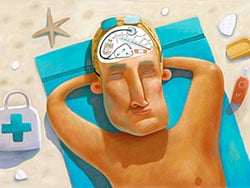About 20% of US physicians took less than 1 week of vacation in the previous year, a new study found. When doctors did go on vacation, 70% reported working on their days off to handle patient-related tasks.
Burnout was more likely among doctors who worked more during vacations and lacked coverage in responding to electronic health messages from patients, according to the cross-sectional study, which was published on January 12, 2024, in JAMA Network Open.
“It’s important to provide physicians with adequate time to disconnect from work and recharge,” said study coauthor Tait Shanafelt, MD, chief wellness officer at Stanford Medicine, in an interview.

The study’s conclusion that most US physicians work on their days off “is a marker of inadequate staffing, suboptimal teamwork, and poorly designed coverage systems,” he added. “Simply allocating people a number of vacation days is not enough.”
According to Shanafelt, there’s been little research into vacation’s impact on physician well-being. However, it is clear that work overload and exhaustion are major problems among American physicians. “Inadequate time off may magnify these challenges.”
Research suggests that physicians suffer more burnout than other US workers even after adjusting for confounders, he said. Extensive evidence shows that burnout in physicians contributes to medical errors and erodes quality of care and patient satisfaction, he added.
For the new study, researchers mailed surveys to 3671 members of the American Medical Association from 2020 to 2021, and 1162 (31.7%) responded. Another 6348 (7.1%) responded to an email survey sent to 90,000 physicians. An analysis suggested the respondents were representative of all US practicing physicians.
Among 3024 respondents who responded to a subsurvey about vacations, about 40% took more than 15 days of vacation over the past year, about 40% took 6-15 days, and about 20% took 5 or fewer days.
Fewer than half of physicians said their electronic health record (EHR) inboxes were fully covered by others while they were away. About 70% said they worked while on vacation, with nearly 15% working an hour or more each day.
Emergency physicians were the least likely and anesthesiologists were the most likely to take at least 15 days of vacation per year, according to the study.
Women were more likely than men to work 30 or more minutes a day on vacation. Physicians aged 65 years and older were more likely to take 15 or more days of vacation per year than those under 35 years.
An adjusted analysis linked complete EHR inbox coverage to lower odds of taking time during vacation to work (odds ratio [OR], 0.68; 95% CI, 0.57-0.80).
“For many, difficulty finding clinical coverage, lack of EHR inbox coverage, and returning to an overwhelming backlog of EHR inbox work at were identified as barriers to taking vacation,” Shanafelt said.
Researchers linked lower rates of burnout to taking more than 3 weeks of vacation per year (OR, 0.59-0.66, depending on time spent; 95% CI, 0.40-0.98) vs none. They also linked less burnout to full EHR inbox coverage while on vacation (OR, 0.74; 95% CI, 0.63-0.88) and more burnout to spending 30 minutes or more on work while on a typical vacation day (OR, 1.58-1.97, depending on time spent; 95% CI, 1.22-2.77).
Study limitations include the low participation rate and lack of insight into causation. It’s not clear how burnout and less vacation time are related and whether one causes the other, Shanafelt said. “It is possible there are a number of interacting factors rather than a simple, linear relationship.”
In an interview, Lazar J. Greenfield, Jr., MD, PhD, professor and chairman of neurology at UConn Health, Farmington, Connecticut, said his department encourages clinicians to plan vacations well ahead of time, and “we make a real strong effort to make sure that people are fully covered and someone has their Epic inbox.”
Greenfield, who wasn’t involved in the new study, recommended that physicians plan active vacations, so they have less downtime to catch up on work matters. But he acknowledged that stepping away from emails can be difficult, especially when physicians fear pileups of work upon their return or don’t want to annoy patients with tardy responses.
“They have a hard time disengaging from their moral obligations to patients,” he said. “Another issue, particularly in my field of neurology, is that there’s a lot of subspecialties. Finding somebody with the exact subspecialty and expertise to cover a very specific patient population they treat can be really hard.”
The Stanford WellMD Center, Mayo Clinic Department of Medicine Program on Physician Well-being, and American Medical Association funded the study.
Shanafelt discloses coinventing the Well-Being Index and its derivatives with another study author; Mayo Clinic licensed the Well-Being Index and pays them royalties outside the submitted work. Shanafelt also reported support for grand rounds, lectures, and advising for healthare organizations outside the submitted work. Other authors reported personal fees from Marvin Behavioral Health and grants from the National Institute of Nursing Research, National Science Foundation, and Med Ed Solutions.
Greenfield had no disclosures.
Randy Dotinga is an independent journalist and board member of the Association of Health Care Journalists.
>>> Read full article>>>
Copyright for syndicated content belongs to the linked Source : Medscape – https://www.medscape.com/viewarticle/time-isnt-really-time-most-physicians-study-finds-2024a10000xm































